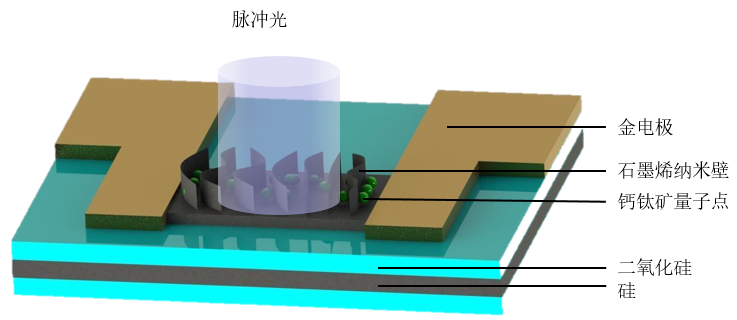Recently, Li Runze from IPC published a paper tilted “CsPbBr3/graphene nanowall artificial optoelectronic synapses for controllable perceptual learning” in PhotoniX. Dr. Dong Yibo, Hujiang Postdoctoral Fellow from IPC was the first author; USST was the first unit. Prof. Chen Xi, Prof. Yue Zengji and Academician Gu Min were the corresponding authors.
The rapid development of neuromorphic computing has stimulated extensive research interest in artificial synapses. Optoelectronic artificial synapses using laser beams as stimulus signals have the advantages of broadband, fast response, and low crosstalk. However, the optoelectronic synapses usually exhibit short memory duration due to the low lifetime of the photo-generated carriers. It greatly limits the mimicking of human perceptual learning, which is a common phenomenon in sensory interactions with the environment and practices of specific sensory tasks. Herein, a heterostructure optoelectronic synapse based on graphene nanowalls and CsPbBr3 quantum dots was fabricated. The graphene/CsPbBr3 heterojunction and the natural middle energy band in graphene nanowalls extend the carrier lifetime. Therefore, a long half-life period of photocurrent decay - 35.59 s has been achieved. Moreover, the long-term optoelectronic response can be controlled by the adjustment of numbers, powers, wavelengths, and frequencies of the laser pulses. Next, an artificial neural network consisting of a 28 × 28 synaptic array was established. It can be used to mimic a typical characteristic of human perceptual learning that the ability of sensory systems is enhanced through a learning experience. The learning behavior of image recognition can be tuned based on the photocurrent response control. The accuracy of image recognition keeps above 80% even under a low-frequency learning process. The team also verifies that less time is required to regain the lost sensory ability that has been previously learned. This approach paves the way toward high-performance intelligent devices with controllable learning of visual perception.
The team reported a HC-type GNWs/CsPbBr3 QDs optoelectronic synapse for the demonstration of human perceptual learning. The synapses can be controllably stimulated by visible laser pulses at different numbers, powers, wavelengths, and frequencies. Through the introduction of GNWs as the QD substrate, the synapse has a long photocurrent decay time owing to the introduction of the unique MGB of GNWs and the use of the built-in electric field between GNWs and CsPbBr3 QDs. Pulsed laser stimulation at 530 nm for 1 s, the half-life period of the photocurrent decay is as high as 35.59 s. The laser response intensity of the transistor-type structure design can be flexibly adjusted by applying an external gate voltage, which can imitate the regulation of the brain’s synaptic excitement in the biological system. Moreover, the laser response results of the device can be processed in a typical neuromorphic way, such as PPF and memory duration tuning. The GNWs/CsPbBr3 QDs optoelectronic synapse can be combined with an ANN, to mimic a kind of human perceptual learning - handwritten digit recognition. Under twenty laser power training, the recognition accuracy is as high as 96.42 %. A rapid accuracy increase is achieved by increasing the numbers and powers of the laser pulses, which is a typical characteristic of perceptual learning. In addition, we have shown that the relearning process takes less time to gain an accuracy enhancement than the first learning. The realization of human perceptual learning has great potential for high-performance artificial intelligence sensory devices.
This research was supported by the Shanghai Municipal Science and Technology Major Project, the Science and Technology Commission of Shanghai Municipality (STCSM), the Zhangjiang National Innovation Demonstration Zone, National Natural Science Foundation of China, and China Postdoctoral Science Foundation.

Link to the paper: https://photonix.springeropen.com/articles/10.1186/s43074-023-00082-8


